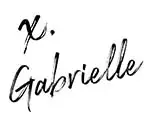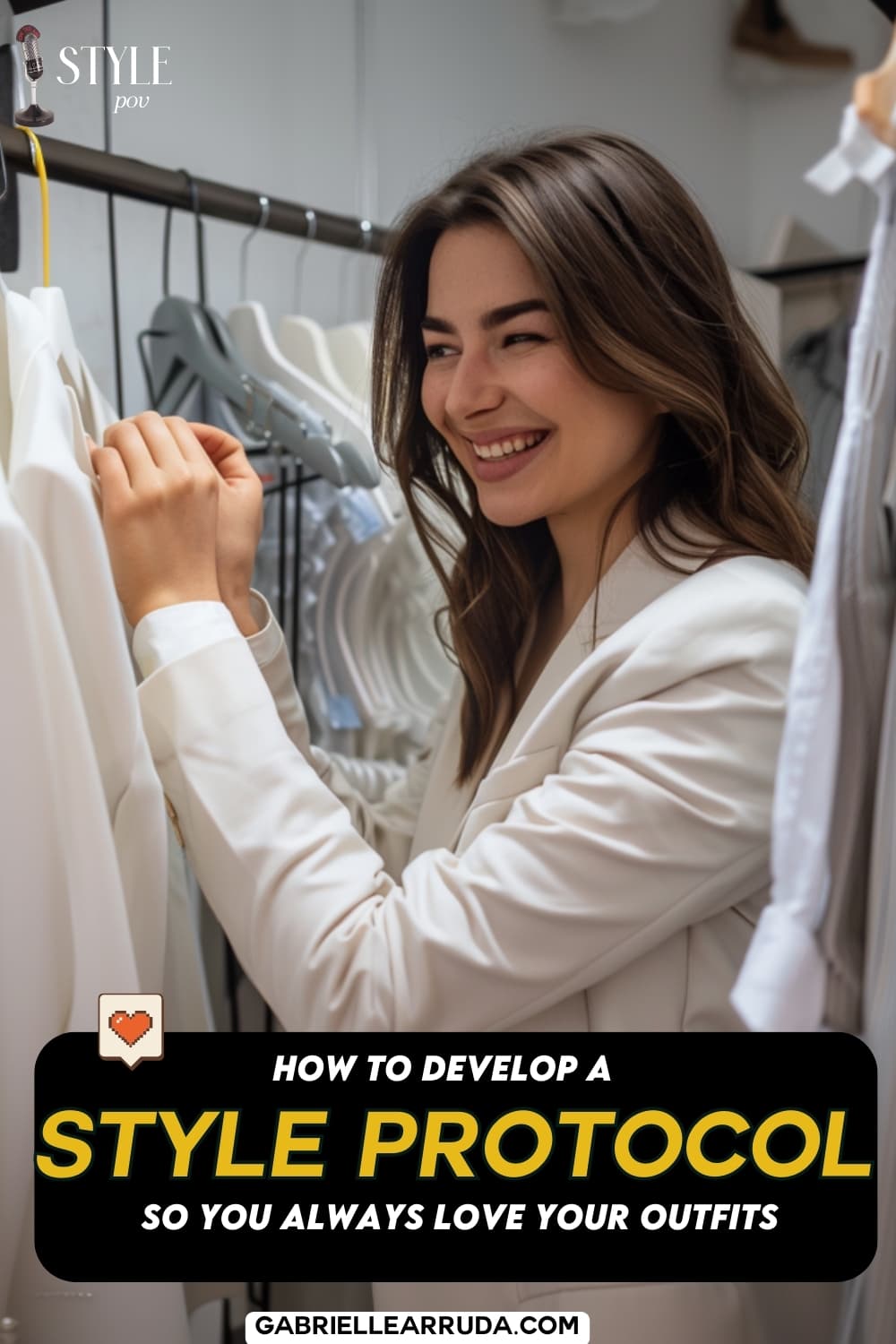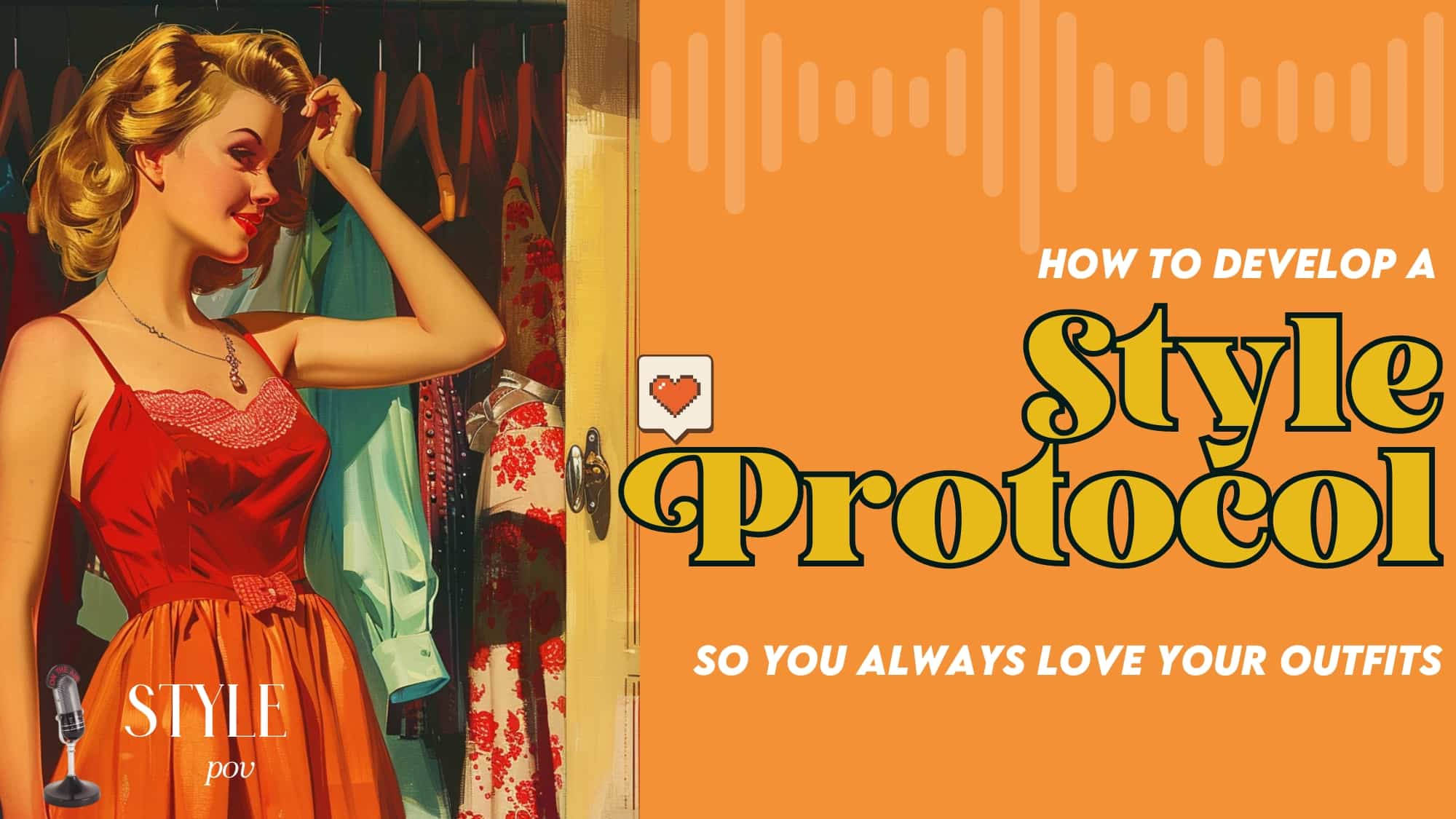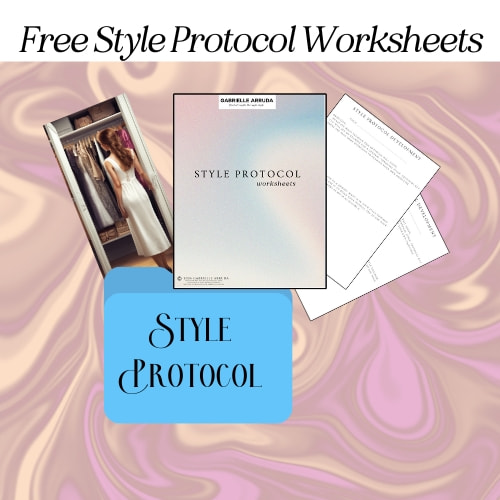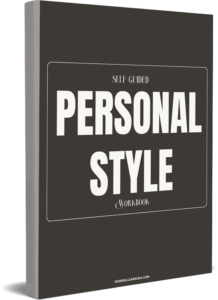The episode discusses the importance of creating a style protocol to optimize one’s fashion choices and achieve style goals. It outlines steps for self-reflection, style toolbox evaluation, experimentation, feedback, and maintenance, emphasizing the need to trust personal fashion instincts and continuously refine one’s style journey.
Listen to it:
We need more outfits that make us feel like we can own the world. You know those ones you wear and a smile just spreads across your face. You stand a little taller, walk with a bit more purpose, and you feel like you are the main character in any room.
Why can’t every outfit be like that? Well, it can!
Hi, I’m Gabrielle Arruda your host for the Style POV podcast and I’m here to help you learn to trust your fashion instincts, hone your authentic style POV, and find strength through style.
Style Protocols: Start Loving ALL Your Outfits
So today we are going to talk about developing a style protocol and why this singular plan with data and contingencies can help you achieve your style goals, tackle any style hurdles, and just get you moving past the messy middle of “does this even look good on me”.
Let’s first start by defining “protocol” for our purposes. Protocol generally means an official set of procedures for what actions to take in a certain situation.
It’s a plan or an agreement. And for this use case, we plan to use both of those concepts, a plan and an agreement.
A systematized way of rules or guidelines one must follow. That you agree is in your best interest to achieve “insert style goal here”.
As a means to explore the relationship between you and your style and a logical sequence of decisions, you can make for your style to achieve the end goal.
So when we discuss a style protocol, it’s essentially a set of logical things you will do in order to optimize your style output success. Or- like the clothes you are wearing and have them function for your daily life. To create more of those outfits that when you look in the mirror you think “Ya, I’m liking this”. Those visceral moments when you’re walking down the street feeling unstoppable and confident in the outfit you chose.
When you develop a protocol (in science) generally you are figuring out the core document that describes the objectives, design, methodology, statistical considerations, and organization of a clinical trial.
But we are not performing clinical trials. So how would this apply to our styles? We are trying to develop our own set of rules backed by data to achieve a specific outcome. These protocols are there to assist us when we are lost in our style, confused about why something isn’t working, or just reaching a plateau and not sure where to go.
So let’s start breaking down how we might evaluate a personalized style protocol.
And in order to develop this is a logical and effective manner, I’ve created a short worksheet for you to fill out to determine your own. It’s free and linked in the show notes.
It’s been proven that writing out (ideally by hand but also typing works) can help you formalize your goal, and improve your chances of actually accomplishing it. Allowing you to develop hope pathways that create motivation and a clear set of action steps. So, I can’t emphasize enough that writing these protocols out will help you cement them in your brain and cognitively engage our motor control centers that allow you to embed that information much more deeply.
Crafting Your Personal Style Protocol: The Steps
The first step: let’s name our protocol. Because there is something about a title that makes it feel official, and specified to this moment in time.
Your title can be broad like Gaby’s Style Protocol or it can be more specific to your current style goal like Gaby’s Kibbe Protocol if you were exploring your image identity.
Next, we want an objective. It may seem like you can just generalize this or think of it in your head, but there is power to formalizing it and writing it out succinctly.
Your objective should be able to be measured in a specific way, but not too narrow. Like you wouldn’t want to create an entire protocol around determining if these earrings work with this outfit. But you might want an Accessories Style Protocol to understand how you like to complete your head-to-toe looks and how you use accessories to exude your unique style pov.
Next for a typical protocol, you would be labeling out your materials or resources. But in the style sector, I think determining your style toolbox is more appropriate. Which is episode 1 if you need a refresher.
Your style toolbox is your tool for creating outfits that you’ve honed and customized to suit your signature style.
Brief break to actually define “signature style”
Now, I know signature style has been questioned lately and I think we might delve into what it actually is in a future podcast episode. And if you happen to be listening to this on YouTube, let me know in the comments if this is interesting.
But, we all have signature styles. Just like we have a written signature. The key here is to not put your signature style in a box with pre-determined aesthetics. But rather take control of the signature style framework by doing identity work, lining up all the facets of your personality and finding an expression that feels authentic.
In my opinion, signature style gets conflated with a singularly defined aesthetic that already exists in our collective perspective, which is abjectly false.
It’s your style. Just like when you sign your name, that’s your actual signature. Your style has a signature as the baseline expression, the key is to control it and put intention behind it.
But, I digress.
How Your Style Toolbox Supports Your Protocol (style goal)
Now, list out on the worksheets your main style toolbox elements. You can even go a step further and find a fellow fashion friend or someone else on a similar aligned style journey and explain what your style toolbox is composed of.
The act of “teaching” someone else how you build outfits is not to literally teach someone how to use YOUR style toolbox. But is more like a test on how well you can succinctly explain in your own words how you use it. This isn’t about quoting experts or regurgitating things you’ve read or watched, but rather formalizing your own thoughts and developing a familiarity with your style toolbox in a new way.
Example Procedural Steps for Style Goal
Ok next up. Procedural steps.
Here is where we formalize the steps we use to achieve that objective. So in the broader context of building an authentic personal style here are some ideas for the procedural steps. And again, download the worksheet if you want to formalize this for yourself.
- Self-Reflection, Where are you starting at?
- Take some time to reflect on where you are in your style journey, what your current lifestyle needs are, and the image you would ideally like to portray in your style.
If you have my self-guided personal style workbook, my workbook walks you through a lot of these steps. And if you don’t, I have a waitlist sign-up linked in the show notes.
- Next, reflect on factors you’re currently studying or using to develop your authentic personal style. Body shape, color palettes, favorite outfits or clothing pieces, and overall aesthetic parameters.
2. Foundational Fashion Gathering
- During this step in the protocol, you are exploring a fashion system or inspiration that you think will help you achieve your objective or elevate your style journey.
- This can involve watching videos, reading books, journaling, taking daily outfit photos, creating collages, and immersing yourself further in your style toolbox
3. Closet Audit
- Next, you want to do a thorough closet audit that allows you to streamline what you actually wear and love, and eliminate pieces that no longer serve your style objective. I have a video on how to do this linked in the show notes. And don’t worry it’s not just about de-cluttering and it includes a lazy girl method too.
- But through this process, we are identifying clothing we love and feel confident in and eliminating what doesn’t align with our truest style pov.
4. Hone Style Toolbox
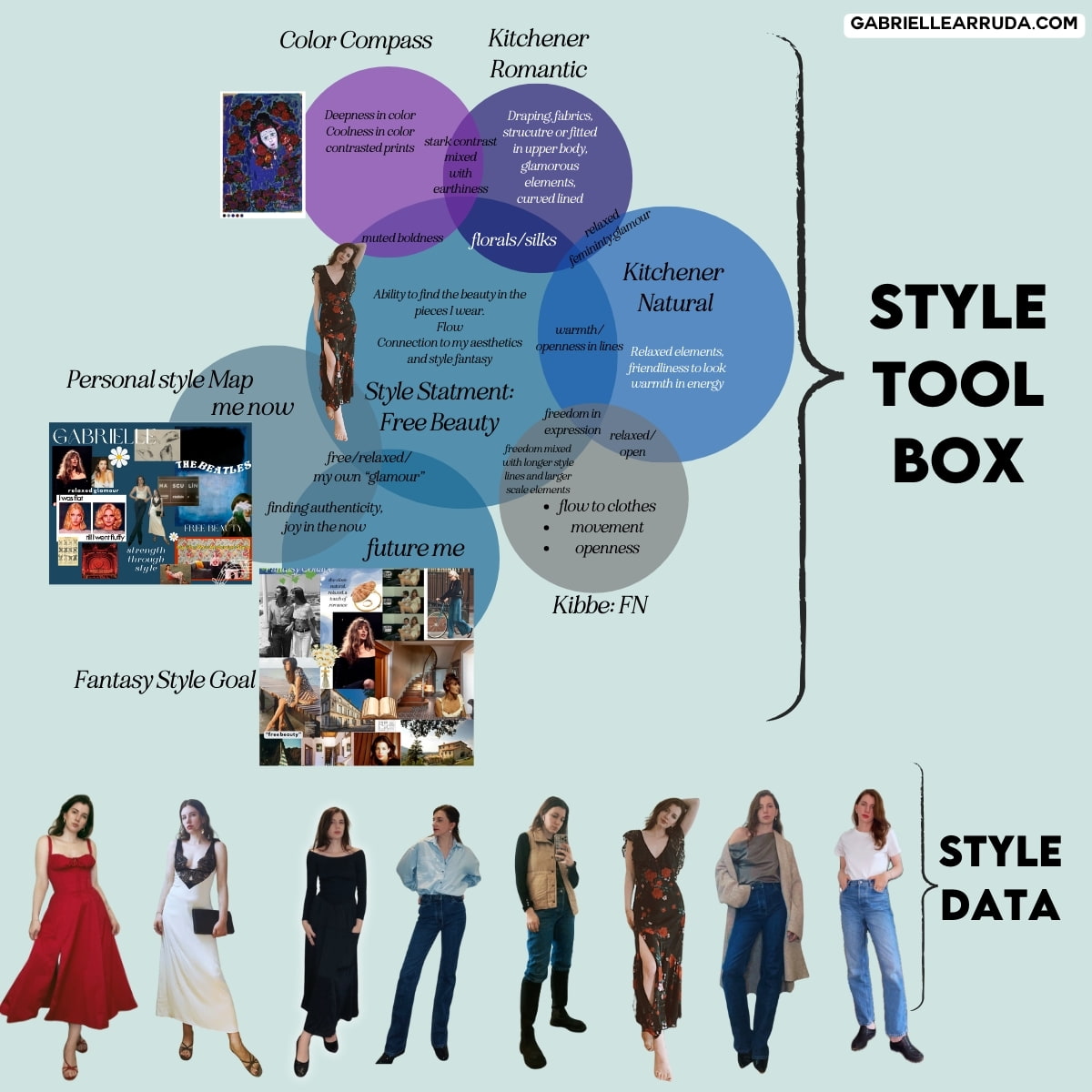
- Just like your personal style, your style toolbox and style parameters evolve. So now is a good time to check in with yourself and your toolbox and determine what style yes’s need to be updated, what data your daily outfit photos are telling you, and give you some more streamlined data to hone the tools you use to build outfits each day.
- We are essentially creating style guidelines here. This could also include any style rules you find helpful and how you like to incorporate trends.
6. Experimentation + Data Collection
- Now, here is where we start to stretch our style creativity to explore how we can use our clothes and how we can combine them to create our own intentional style.
- We can play with the croquis style concept; which is linked in the show notes
- And here is where those daily outfit photos really come into play. Not only the collection but the reflection. And just because your outfit is ugly, or boring, or an outfit repeat- doesn’t matter- you still need to take the photo because it’s all style data to help you get a more personally cohesive style throughout EVERY aspect of your life.
7. Feedback and Self- Evaluation
- We don’t need to do this protocol in a vacuum, but what we do need to consider is that when we ask people for feedback we 1. Ask the right questions 2. Ask the right people 3. Always prioritize your own fashion instincts over others
- For instance, asking random strangers online “What’s my kibbe id” when you don’t understand the system and haven’t spent any time learning it, breaks these rules. You can’t prioritize your own instincts when you have no baseline reference, and you’re asking other people to bestow you with something they aren’t qualified to answer.
- A better example would be: I like the way this forum thinks and prioritizes XYZ in their style like I do. I’m going to ask them what they think about this blazer and how it comes across in this outfit I just built with my style statement in mind. That allows you to get other people’s opinions, but also weigh it against your own knowledge and style statement.
- In the worksheets and in my workbook– there is a lot of time spent self-reflecting and evaluating an outfit. From how it makes you feel, to how to it fits, and how it relates to your style goals. Or in this case your style protocol objective. Take the time and journal it out. You will be surprised by what becomes more conscious during this process and what revelations you uncover by journaling out these thoughts and conclusions.
If you want a supportive and aligned community for fashion feedback, you should check out my free facebook group.
8. Refinement
- Based on feedback and self-evaluation, refine your style choices and make adjustments as needed.
- Continuously iterate on your fashion style, experimenting with new trends and incorporating elements that feel authentic to you.
9. Consider your purchasing strategy and closet strategy moving forward
I have tons of videos on how to shop more strategically on my YouTube channel which is linked, but developing your own shopping rules and closet organization will help avoid any purchase regrets and wasted money.
10. Regularly Review, Adjust/Maintenance

This step could involve just checking in with your style objectives and SMART style goals which we discuss in episode 4.
And accepting that your style journey has no official finish line and it truly will evolve, adapt, and grow with you.
Ok.. Lots of information I know. But within this style protocol, those are our potential procedural steps. Depending on what style objective you have, you may find yourself with fewer steps or more steps.
Create A Positive Style Journey Experience
There is often a step on safety precautions within scientific protocols. And while this is less applicable to style protocols, it couldn’t hurt to jot down a few things you will do to help maintain a healthy relationship with your style during this process. It could include muting influencers who maybe inadvertently make you feel less than or staying off forums that have a gate-keeper energy. Or maybe it’s just making sure you aren’t overly scrutinizing your body or progress.
Set a Timeline to Measure Progress
Next for our style protocol, it helps to have a general timeline. Decide when you want to evaluate your progress toward this objective. And potentially develop some check-in points along the way to measure and tweak progress and procedures.
Like, in six months I want to have a clear sense of my personal style and my style toolbox. But in months 2 and 4, I will evaluate my data and procedures and see if they are moving me closer to this goal.
Next, we have roles and responsibilities. This is optional but it could be deciding if you have anyone you want to include in your journey, complete these steps together, or commit to a style challenge together. Or it could be designating a safe-style space to share your style wins with.
Next, we have to decide how we will monitor our progress and this should be a highly personalized step.
Will it be when you feel good in your outfits? Will it be when your clothes fit better or look more polished? Will it be when you can create an outfit easily in 5 minutes or less?
Because personal style is so subjective, you need to customize this monitor benchmark to express what will YOU need to feel good in your style or style objective.
Anticipating Any Setbacks and Planning Accordingly
Next, we list out any contingency plans we might need. Anticipating obstacles can make them feel less scared when we encounter them. Setbacks and ruts are normal. The more you can write out what potential setbacks might occur, the less they will stagnate you.
One could be, I tend not to take daily outfit photos when I’m busy because my outfits are boring and I’m too stressed. So in order to keep this going, I’m going to create an easy set-up that I don’t need to break down so taking the photo only takes 30 seconds, and I” ‘m going to habit-stack it after I brush my teeth so it becomes second nature.
And then finally, a general conclusion.
After thinking about all these steps (and ideally writing them all out) you should feel very confident in the steps you need to take to achieve that personal style.
This is just wrapping up what you wrote about and summarizing your goal.
Now, this isn’t meant to remove the creativity and joy that your style should bring. But it should instead serve as a directive to lean on when your style isn’t moving where you want it to, or you’re not sure why this works or why that doesn’t.
It’s a framework that allows you to systematize your journey and get the most impactful insights from your efforts.
Instead of just trying a million new pieces of clothing on, or trying this outfit you saw, or buying that jacket you liked, this gives you a protocol to have more confidence in your style, which in turn allows you to start trusting your own fashion instincts.
At What Point Can a Style Protocol Help Me?
So the next question I’m anticipating- is when should I develop a style protocol? Is it only for when I’m struggling with my style?
Nope- you can start one anytime in your style journey, and in fact, you should evolve your style protocol and objective after you’ve made measurable progress in achieving it.
If you’re loving your style right now, this style protocol can help you really dig into what’s working and find the journey to do “more of that”.
And if you’re in the messy middle or struggling to understand style systems, then this will give you an actionable set of steps to work through.
It’s less throw spaghetti at the wall until it sticks. And instead more… methodically planning and executing a targeted approach.
I know, it sounds so sexy. haha.

But, we are here to find strength through style, develop our own unique style POVs, and learn to trust our own fashion instincts.
BIG, BIG goals.
So it’s all about methodology as the vehicle for your creativity and self-expression.
Thank you for tuning in this week, Until Next time.
